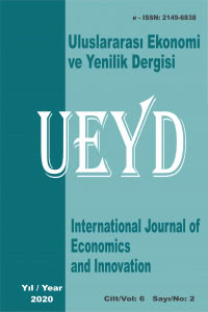Covid-19, Yatırımcı Duyarlılığı ve Pay Piyasaları Arasında Bulaşma Etkisi
Bu çalışmada, finansal piyasalar arasında bulaşma etkisine neden olabilecek yatırımcı duyarlılığı, Covid-19 salgın dönemi için DCC-GARCH modeli ile incelenmektedir. Çalışmadan elde edilen bulgular, Dünya Sağlık Örgütü’nün Covid-19’u bulaşıcı bir salgın hastalık olarak ilan ettikten sonra ölüm oranı en düşük ve en yüksek ülkeler arasındaki zamanla değişen korelasyon katsayılarının arttığını göstermektedir. Çoğu durumda bulaşma etkinin olduğuna dair kanıtlar elde edilmiştir. Genel olarak, yatırımcı duyarlılığının Covid-19 salgın döneminde pay piyasaları arasındaki korelasyonu artırmak suretiyle bulaşma etkisine neden olduğu görülmektedir.
Anahtar Kelimeler:
Pay Piyasası Korelasyonları, Bulaşma Etkisi, Yatırımcı Duyarlılığı, Covid-19 Etkisi Çalışmaları
Covid-19, Investor Sentiment and Contagion Across Stock Markets
This study examines investor sentiment which may trigger contagion in financial markets during the recent Covid-19 outbreak within a DCC-GARCH model. The results show that most of the time-varying correlations have risen after the Covid-19 outbreak until the WHO declared the disease as a global pandemic and most of the rise in correlations occurs within each group of countries/regions where the least and the most deaths took place. There is evidence of contagion in most cases. Overall, investor sentiment seems to give rise to contagion as the correlations between stock markets have increased during the global Covid-19 pandemic.
___
- Corredor, P., Ferrer, E., & Santamaria, R. (2013). Investor sentiment effect in stock markets: Stock characteristics or country-specific factors? International Review of Economics & Finance, 27, 572–591. https://doi.org/10.1016/j.iref.2013.02.001
- Çütcü, İ., & Kılıç, Y. (2020). Stock Market Response to Coronavirus (COVID-19) Pandemic. Journal of Applied Economics & Business Research, 10(4), 207-220.
- Debata, B., Dash, S. R., & Mahakud, J. (2018). Investor sentiment and emerging stock market liquidity. Finance Research Letters, 26, 15–31. https://doi.org/10.1016/j.frl.2017.11.006
- Engle, R. (2002). Dynamic Conditional Correlation. Journal of Business & Economic Statistics, 20(3), 339–350. https://doi.org/10.1198/073500102288618487
- Johnston, W. M., & Davey, G. C. L. (1997). The psychological impact of negative TV news bulletins: The catastrophizing of personal worries. British Journal of Psychology, 88(1), 85–91. https://doi.org/10.1111/j.2044-8295.1997.tb02622.x
- Kaplanski, G., & Levy, H. (2010). Sentiment and stock prices: The case of aviation disasters. Journal of Financial Economics, 95(2), 174–201. https://doi.org/10.1016/j.jfineco.2009.10.002
- Khan, M. A., Hernandez, J. A., & Shahzad, S. J. H. (2019). Time and frequency relationship between household investors’ sentiment index and US industry stock returns. Finance Research Letters, 101318. https://doi.org/10.1016/j.frl.2019.101318
- Niţoi, M., & Pochea, M. M. (2020). Time-varying dependence in European equity markets: A contagion and investor sentiment driven analysis. Economic Modelling, 86, 133–147. https://doi.org/10.1016/j.econmod.2019.06.007
- Peterson, P. P. (1989). Event Studies: A Review of Issues and Methodology. Quarterly Journal of Business and Economics, 28(3), 36–66. JSTOR.
- Shan, L., & Gong, S. X. (2012). Investor sentiment and stock returns: Wenchuan Earthquake. Finance Research Letters, 9(1), 36–47. https://doi.org/10.1016/j.frl.2011.07.002
- Kılıç, Y . (2020). Borsa İstanbul’da COVID-19 (Koronavirüs) Etkisi . JOEEP: Journal of Emerging Economies and Policy , 5 (1) , 66-77 . Retrieved from https://dergipark.org.tr/en/pub/joeep/issue/53777/734904
- Yeo, L. H. (2020). Impact of Covid-19 pandemic on Asia-Europe relations. Asia Europe Journal, 1–4. https://doi.org/10.1007/s10308-020-00575-2
- Zhang, D., Hu, M., & Ji, Q. (2020). Financial markets under the global pandemic of COVID-19. Finance Research Letters, 101528. https://doi.org/10.1016/j.frl.2020.101528
- Zhao, L., Wang, J., Huang, R., Cui, H., Qiu, X., & Wang, X. (2014). Sentiment contagion in complex networks. Physica A: Statistical Mechanics and Its Applications, 394, 17–23. https://doi.org/10.1016/j.physa.2013.09.057
- ISSN: 2149-6838
- Yayın Aralığı: Yılda 2 Sayı
- Başlangıç: 2015
- Yayıncı: Seyfettin Artan
Sayıdaki Diğer Makaleler
Türkiye'nin Doğal Gaz Ticaret Merkezi Oluşturma Sürecinin Değerlendirmesi
OECD Ülkelerinde Vergi Takozu ve İşsizlik İlişkisi
An Evaluation of Turkey’s Natural Gas Hub Development Process
Songül KAKİLLİ ACARAVCI, Yavuz ŞENTÜRK
Kurumsal İtibar ile Finansal Performans Arasındaki İlişkide İnovasyon Kapasitesinin Aracılık Etkisi
Savunma Sanayi Ar-Ge Merkezlerinin Performanslarının Entropive Aras Yöntemleri İle Değerlendirilmesi
Türkiye'nin Doğal Gaz Ticaret Merkezi Oluşturma Sürecinin Değerlendirmesi
Doğrudan Yabancı Yatırımların Seçilmiş Bankaların Karlılığı Üzerine Etkileri
